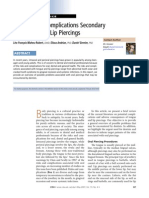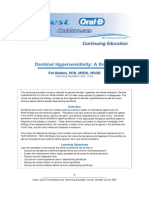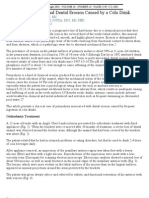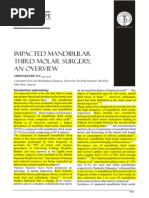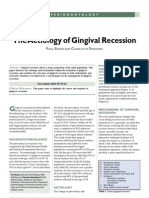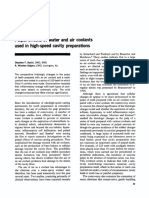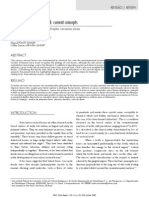Barodontalgia As A Differential Diagnosis PDF
Barodontalgia As A Differential Diagnosis PDF
Uploaded by
David ColonCopyright:
Available Formats
Barodontalgia As A Differential Diagnosis PDF
Barodontalgia As A Differential Diagnosis PDF
Uploaded by
David ColonOriginal Title
Copyright
Available Formats
Share this document
Did you find this document useful?
Is this content inappropriate?
Copyright:
Available Formats
Barodontalgia As A Differential Diagnosis PDF
Barodontalgia As A Differential Diagnosis PDF
Uploaded by
David ColonCopyright:
Available Formats
C
L I N I C A L
R A C T I C E
Barodontalgia as a Differential Diagnosis:
Symptoms and Findings
Roland Robichaud, BSc (Hon)
Mary E. McNally, MSc, DDS, MA
A b s t r a c t
This paper provides a review of the literature concerning the etiology and manifestations of barodontalgia, as well
as important clinical considerations for its management. Barodontalgia is characterized by exposure to a pressure
gradient, such as that experienced by underwater divers, aviation personnel and air travellers. This form of dental
pain is generally marked by a predisposing dental pathology such as acute or chronic periapical infection, caries,
deep or failing restorations, residual dental cysts, sinusitis or a history of recent surgery. Studies indicate that severity of barodontalgia and the resulting deterioration of dental health correlates with duration of barometric stress.
Restorative materials are also affected by pressure gradients. Resin is indicated as a luting agent of choice for
cementing fixed prostheses in populations at risk for barodontalgia. Under the influence of pressure gradients, resin
cements maintain original bond strength and demonstrate the least amount of microleakage compared with other
cements. The key to avoiding barodontalgia is good oral health. Clinicians must pay close attention to areas of
dentin exposure, caries, fractured cusps, the integrity of restorations and periapical pathology in those at risk. The
Fdration dentaire internationale describes 4 classes of barodontalgia based on signs and symptoms and provides
specific and valuable recommendations for therapeutic intervention.
MeSH Key Words: aerospace medicine; barotrauma/complications; diving/injuries; toothache/etiology
J Can Dent Assoc 2005; 71(1):3942
This article has been peer reviewed.
uring World War II, tooth pain experienced by air
crew in flight was given the name aerodontalgia.
However, as this tooth-related pain was also
observed in divers, a broader, more appropriate term, barodontalgia, was subsequently given to this phenomenon.1
Barodontalgia, which affects air crew and aircraft passengers as well as underwater divers, is pain or injury affecting
teeth due to changes in pressure gradients.2 Boyles Law,
which states that at a given temperature, the volume of a
gas is inversely proportional to the ambient pressure, may
be used to explain barodontalgia.2 Specifically, as a person
descends deeper and deeper below the water surface, pressure exerted on the diver by the water increases and reduces
the volume of gases in enclosed spaces such as teeth and
sinuses. The same law applies if a person climbs to high altitudes (in flight); in this case, outside pressure decreases,
permitting the volume of gases to increase. A problem arises
when the enclosed spaces containing gases cannot expand
or contract to adjust the internal pressure to correspond to
the outside pressure. Aircraft personnel and passengers travelling in non-pressurized cabins are especially at risk.2
Journal of the Canadian Dental Association
The importance of understanding, preventing and,
where necessary, treating barodontalgia is especially evident
when considering pilots of high performance aircraft. A
study using a pressure chamber as a flight simulator revealed
that in some instances barodontalgia was severe enough to
affect flight safety.3 In the past, barodontalgia was especially
problematic for travellers during military flights where
cabins were not sufficiently pressurized. Currently, and of
particular relevance to the general public, are effects occurring during normal commercial flights and recreational
diving. These range from a simple sharp or squeezing tooth
pain to rupture of the alveolar mucosa.2 The phenomenon
begins to occur at an altitude of approximately 3,000 m and
at a water depth of 10 m where the ambient pressures are
0.75 and 1 atmosphere, respectively.4
Etiology
The cause of barodontalgia has been investigated for many
years. Kollman3 refers to 3 important hypotheses to explain
this phenomenon: expansion of trapped air bubbles under
a root filling or against dentin that activates nociceptors;
January 2005, Vol. 71, No. 1
39
Robichaud, McNally
stimulation of nociceptors in the maxillary sinuses, with pain
referred to the teeth; and stimulation of nerve endings in a
chronically inflamed pulp. He strongly supports the last 2
hypotheses and states that, for the latter, histologic evidence
shows that chronic pulpal inflammation can still be present
even when a thin dentin layer covers the pulp, for example,
as in a deep cavity preparation.
Most cases of barodontalgia are associated with teeth
already affected by some sort of pathology.1 Clinically,
people affected by barodontalgia were found to have one or
more of the following: acute or chronic periapical infection,
caries, deep restorations, residual dental cysts, sinusitis
and a history of recent surgery.5 The latter is of particular
concern for people wearing oxygen regulators when diving
using self-contained underwater breathing apparatus
(scuba) or when wearing oxygen masks during highperformance aircraft flights due to the risk of air being
pushed into the tissues. Sinusitis may also contribute to
barodontalgia, although it may not be related to any tooth
pathology. For example, Holowatyj1 described a patient as
having pain in his left infraorbital area, as well as in the
maxillary left canine and maxillary left first molar during
both a commercial flight and while flying a Tutor jet
trainer. Although no tooth pathology was present, the
patient did have mild congestion in his left maxillary sinus,
with referred pain in his maxillary teeth. Barosinusitis is
distinguishable from barodontalgia, as the former will
always occur on descent, whereas the latter always begins
on ascent.5 Recognizing that symptoms only appear to
arise in teeth (or sinuses) affected by some type of pathology, researchers concluded that a pressure gradient is a
contributing factor, not the actual cause of the problem.2
Calder and Ramsey6 tested whether large, rapid pressure
changes generated within a capsule would create visibly
detectable damage to extracted restored and nonrestored
teeth. Of 86 extracted teeth subjected to the high-pressure
environment, only 5 showed visible evidence of trauma.
However, all 5 had inferior-quality restorations (i.e., deteriorating or leaking restorations present before extraction or
placed after extraction). None of the unrestored teeth,
regardless of the presence of caries, suffered any damage,
suggesting that failing restorations play a major role in the
occurrence of physical damage.
Underwater Diving
Scuba diving is one of the fastest growing sports in the
world.7 Thus, it is important for dentists to be aware of
dental-related problems that may arise for scuba divers. The
most common way for air from the pressurized tanks to
enter a tooth is by being forced in through carious lesions
or defective margins.7 As atmospheric pressure decreases
during ascent, trapped gases may expand and enter dentin
tubules, thereby stimulating nociceptors in the pulp or
causing the movement of pulp chamber contents through
the apex of the tooth, also causing pain.7
In their study, Calder and Ramsey6 mention that the
40
January 2005, Vol. 71, No. 1
physical properties of the gas mixture used during deep sea
diving may contribute to barodontalgia. In scuba tanks,
oxygens natural diluent gas, nitrogen, is replaced by
helium, resulting in a gas of lower viscosity. This gas can
enter tissues, including teeth, and can sometimes become
trapped in closed spaces, such as the pulp chamber and root
canal. There are 2 mechanisms by which gases can be
trapped in spaces: if there is a space between a tooth and its
restoration, gas may be forced into it during an increase in
pressure; and dissolved gas may diffuse from tissues into
spaces as pressure decreases. Consistent with Boyles Law,
trapped gas will expand and the resulting stress may cause
tooth fracture. This process has been called odontecrexis, a
Greek word meaning tooth explosion.
Physical Manifestations
Although understanding the etiology of barodontalgia is
of great importance, its physical manifestations also deserve
some attention. In their study, Goethe and coworkers8
attempted to identify early and late damage due to barodontalgia by examining 50,000 tooth-related clinical problems (e.g., carious lesions, tooth trauma, deteriorating
restorations) at the Nautical Medical Institute of the
German Navy at Kiel. Among these findings, 13,618 were
from 2,580 navy divers, frogmen and submariners. The
patients were divided into 2 categories: those working
under normal atmospheric pressure (1,291 submariners)
and those working under changed atmospheric pressure
(1,289 divers and frogmen). Navy divers spend an average
of 200300 hours a year under water whereas frogmen
usually spend longer times at shallower depths.
An initial examination revealed that overall, divers and
frogmen had better oral health than submariners. Dental
findings were reviewed at 3, 6, and 9 years. At 9 years, deterioration in the teeth of navy divers and frogmen had
occurred at significantly higher rates than those of the
submariners in terms of missing or crowned incisors,
canines, premolars and molars. More specifically, although
they were healthier at baseline, frogmen were in the poorest state of dental health after 9 years, surpassing even
the navy divers. This suggests a correlation between the
deterioration of dental health and increased exposure to
barometric stress.
To further support these results, another longitudinal
study8 was conducted on navy divers and submariners from
the time of their entry into the navy until they had served
for more than 10 years. Once again, the dental health status
of navy divers was initially slightly better, but after 10 years,
they demonstrated a 300% increase in missing teeth and
a 900% increase in the placement of crowns. The
submariners examination at 10 years revealed an increase
of only 186% missing teeth and 375% crown placement.
These findings confirm that navy divers teeth have a faster
rate of deterioration than submariners. Again, this is attributed to higher levels of barometric stress.
Journal of the Canadian Dental Association
Barodontalgia as a Differential Diagnosis: Symptoms and Findings
Dental Materials
Recommendations
We have described the signs and symptoms of barodonAlthough barodontalgia is not common, it should not be
talgia, such as pain and physical damage to the oral tissues,
dismissed as unimportant, as it can pose a serious safety risk
but it would also be an advantage to the clinician to know
to divers, submariners, pilots and airline passengers. The
the effect of pressure changes on certain dental materials in
Fdration dentaire internationale (FDI) has classified baroterms of bond strength and microleakage. The following
dontalgia into 4 groups according to its signs and symptoms;
outlines important considerations for cast-crown placement
from moderate to severe, they are acute pulpitis, chronic
in people who regularly engage in activities associated with
pulpitis, necrosis of the pulp and periapical abscess or a cyst.8
Each category contains a description of clinical symptom,
barometric stress.
findings and therapy. FDI also recommends an annual
Lyons and coworkers4 examined whether pressure cycles
would cause microleakage in teeth with full cast crowns
checkup for divers, submariners and pilots, with oral hygiene
cemented with zinc phosphate cement, tri-cured glass
instructions from dentists familiar with their dental requireionomer cement or a resin cement. They also investigated
ments. In addition, patients should not dive or fly in nonwhether the retention of these crowns would be affected.
pressurized cabins within 24 hours of a dental treatment
Sixty single-rooted extracted premolars were divided into
requiring anesthetic or 7 days following a surgical treatment.8
The key feature in avoiding barodontalgia is good oral
3 groups of 20 teeth according to the cement used. Each
health. When dealing with patients involved in diving or
group was then subdivided into 2 groups of 10, an experiaviation, clinicians should pay close
mental group and a control group.
attention to areas of dentin expoEach experimental tooth was then
sure, caries, fractured cusps, fillings
subjected to 15 compression cycles,
and periapical pathology.2 If a
ranging from 0 to 3 atmospheres, in a
Barodontalgia can pose a
patient arrives in the office
pressure chamber. Maximum pressure
serious safety risk to divers,
complaining of symptoms of barowas attained in 3 minutes and maindontalgia, the examiner should
tained for 3 minutes, and decompressubmariners, pilots and
establish whether there is a history
sion occurred over 3 minutes.
airline passengers.
of recent flying or diving.
Microleakage was detected in all
Examination should include an estiexperimental teeth where the crowns
mate of the age of restorations in the
were luted with zinc phosphate
suspected area, screening for caries
cement. Seven teeth in the glass
and poor-quality restorations, a percussion test on
ionomer experimental group showed microleakage during
suspected teeth, an evaluation of the response to electrical
pressure cycling, and no microleakage was detected in the
stimulation or heat and cold, as well as a radiographic
resin cement group.
examination.4 One clinical benefit of barodontalgia is that
Lyons and coworkers offer several explanations for the
it may help a dentist locate early caries, leaking restorations
microleakage in the glass ionomer and zinc phosphate
and periodontal abnormalities.5 Also of clinical importance,
groups, including volumetric contraction or internal stress
the placement of a zinc oxide eugenol (ZOE) base was
within the materials, or porosities caused by mixing that
found to prevent barodontalgia when reversible pulpitis was
may have expanded and contracted during pressure cycling.
the underlying cause.1 This is attributed to the well-known
They further suggest that microleakage may not have
sedative affects of ZOE. Another study3 suggested that
occurred in the resin cement group because the dentinal
when treating people who are subjected to large pressure
tubules were obstructed by resin tags, or simply because
changes, it is best to avoid procedures such as pulpectomy
fracture did not occur because the material was flexible.
and capping of an exposed pulp. Rather, endodontic treatThe tensile bond strength of the cements was also tested
ment is indicated.
using a universal testing machine (with a speed of
0.5 mm/minute and a 100-kg load).4 Results indicated that
Conclusion
the force required to dislodge the crowns in the experimenAccording to the literature, barodontalgia is a rather rare
tal group cemented with zinc phosphate was only a tenth
phenomenon. However, Kollmann3 has suggested that the
that of the controls, and that for glass ionomer was reduced
incidence of barodontalgia may be underestimated. For
by a half compared with its controls. Pressure cycling did
example, aviators may be reluctant to report pain as they
not affect the bond strength of the resin cement group.
could be refused flying certificates.
Based on the results of this study, it is possible that baroIt appears that controversy still exists as to the exact etioldontalgia may develop as a result of microleakage following
ogy of barodontalgia and the mechanisms of the pain.
a reduction in lute bond strength during or following presNevertheless, research has provided useful ways to anticisure cycling. Lyons and coworkers suggest that dentists
pate, recognize and treat the phenomenon, thereby preventconsider using a resin cement when luting fixed prostheses
ing what could easily turn into a tragedy. Agreement has
in patients who will be exposed to significant variations
been reached on 2 factors: the influence of a pressure
in pressure.
Journal of the Canadian Dental Association
January 2005, Vol. 71, No. 1
41
Robichaud, McNally
gradient and some sort of pathology in oral tissues or
sinuses must both be present to result in symptoms of barodontalgia. Certain populations have been specifically identified as having a high risk for barodontalgia. Dentists will
be able to provide more efficient diagnosis and care by
referring to FDI guidelines, as well as knowing how certain
dental materials respond to pressure gradients. Although its
occurrence has been known for some time, more research
to improve the understanding of barodontalgia would be
useful for those providing care. Understandably, many
studies are military based because of the potential impact of
barodontalgia on the professional activities of pilots and
divers. With a significant number of these professionals in
the military, there is an optimum environment for carrying
out well-controlled research and follow-up. However, a
richer understanding of diagnosis and treatment challenges
would undoubtedly be gained from research broadened to
include recreational divers and civilian aviators. C
Roland Robichaud is a third-year dental student in the
faculty of dentistry, Dalhousie University, Halifax,
Nova Scotia
Dr. McNally is assistant professor, department of dental
clinical sciences, faculty of dentistry, Dalhousie
University, Halifax, Nova Scotia.
Correspondence to: Dr. Mary McNally, Department of Dental
Clinical Sciences, Faculty of Dentistry, Dalhousie University,
Halifax, NS B3H 3J5. E-mail: mary.mcnally@dal.ca.
The authors have no declared financial interests.
References
1. Holowatyj R. Barodontalgia among flyers: a review of seven cases.
J Can Dent Assoc 1996; 62(7):57884.
2. Kieser J, Holborow D. The prevention and management of oral barotrauma. N Z Dent J 1997; 93(414):1146.
3. Kollmann W. Incidence and possible causes of dental pain during
simulated high altitude flights. J Endod 1993; 19(3):1549.
4. Lyons KM, Rodda JC, Hood JA. Barodontalgia: a review, and the
influence of simulated diving on microleakage and on the retention of full
cast crowns. Mil Med 1999; 164(3):2217.
5. Rauch JW. Barodontalgia dental pain related to ambient pressure
change. Gen Dent 1985; 33(4):3135.
6. Calder IM, Ramsey JD. Odontecrexis the effects of rapid decompression on restored teeth. J Dent 1983; 11(84):31823.
7. Jagger RG, Jackson SJ, Jagger DC. In at the deep end an insight into
scuba diving and related dental problems for the GDP. Br Dent J 1997;
183(10):3802.
8. Goethe WH, Bater H, Laban C. Barodontalgia and barotrauma in the
human teeth: findings in navy divers, frogmen, and submariners of the
Federal Republic of Germany. Mil Med 1989; 154(10):4915.
42
January 2005, Vol. 71, No. 1
Journal of the Canadian Dental Association
You might also like
- Rubber Dam Isolation For Endodontic Treatment in Difficult Clinical SituationsDocument8 pagesRubber Dam Isolation For Endodontic Treatment in Difficult Clinical SituationsDavid ColonNo ratings yet
- Materi 1 Dr. Apt. Diana Laila Ramatillah, M.farmDocument32 pagesMateri 1 Dr. Apt. Diana Laila Ramatillah, M.farmDimas RfNo ratings yet
- Australian Dental Journal - 2011 - Zadik - Diving Dentistry A Review of The Dental Implications of Scuba DivingDocument7 pagesAustralian Dental Journal - 2011 - Zadik - Diving Dentistry A Review of The Dental Implications of Scuba DivingwhistlebloweraimsmohaliNo ratings yet
- Diving Dentistry - A Review of The Dental Implications of Scuba Diving (2011)Document7 pagesDiving Dentistry - A Review of The Dental Implications of Scuba Diving (2011)JohnNo ratings yet
- Barodontalgia A Diagnostic Dilema in The Dental PainDocument5 pagesBarodontalgia A Diagnostic Dilema in The Dental PainLiga Odontopediatria RondonienseNo ratings yet
- The Case For Environmental Etiology of Malocclusion in Modern Civilizations-Airway Morphology and Facial GrowthDocument26 pagesThe Case For Environmental Etiology of Malocclusion in Modern Civilizations-Airway Morphology and Facial GrowthMoises Adriano Pulido GuimarãesNo ratings yet
- Full TextDocument5 pagesFull TextEdwin WardhanaNo ratings yet
- Barodontalgia: Wednesday, October 03, 2012 1Document38 pagesBarodontalgia: Wednesday, October 03, 2012 1marukala100% (2)
- Cases Journal: Gingival Health in Relation To Clinical Crown Length: A Case ReportDocument3 pagesCases Journal: Gingival Health in Relation To Clinical Crown Length: A Case ReportBruno Adiputra Patut IINo ratings yet
- Dysbaric Osteonecrosis in Diving Fisherman: A Case Report: Seher Kurtul, Nejdiye GüngördüDocument3 pagesDysbaric Osteonecrosis in Diving Fisherman: A Case Report: Seher Kurtul, Nejdiye GüngördüZiya Rasim CİVELEKNo ratings yet
- Barodontalgia What Have We Learned in The Past DecadeDocument5 pagesBarodontalgia What Have We Learned in The Past DecadeR KNo ratings yet
- Tooth Surface Loss An OverviewDocument7 pagesTooth Surface Loss An OverviewdrlenaaaNo ratings yet
- Rehabilitacion de La Denticion Desgastada - Johansson Et Al - JOR 2008Document19 pagesRehabilitacion de La Denticion Desgastada - Johansson Et Al - JOR 2008Pablo BenitezNo ratings yet
- SRMJResDentSci73158-2129782 003529Document4 pagesSRMJResDentSci73158-2129782 003529MarsyaNo ratings yet
- Johannson - Erosion - 2012 PDFDocument18 pagesJohannson - Erosion - 2012 PDFRusevNo ratings yet
- Alveolar Bone Width Preservation After Decoronation of Ankylosed Anterior IncisorsDocument4 pagesAlveolar Bone Width Preservation After Decoronation of Ankylosed Anterior IncisorsVincent LamadongNo ratings yet
- Lip PiercingDocument5 pagesLip PiercingDana PopaNo ratings yet
- Dentinal Hypersensitivity: A Review: Pat Walters, RDH, MSDH, MSOBDocument13 pagesDentinal Hypersensitivity: A Review: Pat Walters, RDH, MSDH, MSOBLuciana CatherinoNo ratings yet
- Etiology - Pulpal IrritantsDocument18 pagesEtiology - Pulpal IrritantsAnang AbdulfattahNo ratings yet
- Dent. 24 34-9.: en Ortodoncia. 1 . Edición. Editorial Panamericana. MéxicoDocument7 pagesDent. 24 34-9.: en Ortodoncia. 1 . Edición. Editorial Panamericana. MéxicoVidal AlmanzaNo ratings yet
- Aviation Dentistry - Current Concepts and PracticeDocument6 pagesAviation Dentistry - Current Concepts and PracticeMaria Gerber RozaNo ratings yet
- Airway Emodule - Airway Assessment PDFDocument6 pagesAirway Emodule - Airway Assessment PDFPreetam PatnalaNo ratings yet
- Weerheijm 2001Document2 pagesWeerheijm 2001Matíasssp PardoNo ratings yet
- Aviation Dentistry Past To Present.11Document3 pagesAviation Dentistry Past To Present.11whistlebloweraimsmohaliNo ratings yet
- Biocompatibility of Dental Materials - Part 2Document160 pagesBiocompatibility of Dental Materials - Part 2srinivasanNo ratings yet
- CASE REPORT Unusual Dental Erosion Caused by A Cola DrinkDocument5 pagesCASE REPORT Unusual Dental Erosion Caused by A Cola DrinkAlina BortaNo ratings yet
- Ultrasonic Scaling: Associated Risks.: Review ArticleDocument5 pagesUltrasonic Scaling: Associated Risks.: Review Articlevivi alfiyani noorNo ratings yet
- Sulcus Mucosal Slicing TechniqueDocument10 pagesSulcus Mucosal Slicing TechniqueChrisNo ratings yet
- ADJ2009 - Abfraction Separating Fact From CtionDocument7 pagesADJ2009 - Abfraction Separating Fact From CtionEdward LiuNo ratings yet
- Fracture of A Sound Tooth in A Pilot Under Hypobaric ConditionsDocument3 pagesFracture of A Sound Tooth in A Pilot Under Hypobaric ConditionsalfianNo ratings yet
- Ref12 PDFDocument7 pagesRef12 PDFmandible removerNo ratings yet
- The Aetiology of Gingival RecessionDocument4 pagesThe Aetiology of Gingival RecessionshahidibrarNo ratings yet
- White1997 Dental Calculus Formation EtcDocument16 pagesWhite1997 Dental Calculus Formation EtcJose Salas AdragnaNo ratings yet
- Trauma From OcclusionDocument3 pagesTrauma From OcclusionSuganya MurugaiahNo ratings yet
- Candida-Associateddenturestomatitis - Aetiologyand Management: Areview - Part2.Oraldiseasescausedby Candida SpeciesDocument7 pagesCandida-Associateddenturestomatitis - Aetiologyand Management: Areview - Part2.Oraldiseasescausedby Candida SpeciesDentist HereNo ratings yet
- Etiology MaloclusionDocument3 pagesEtiology MaloclusionRiskha Febriani HapsariNo ratings yet
- Implications, Prevention and Management of Subcutaneous Emphysema During Tic TreatmentDocument7 pagesImplications, Prevention and Management of Subcutaneous Emphysema During Tic TreatmentFlorin IonescuNo ratings yet
- Pulpal Effects of Water and Air Coolants Used in High-Speed Cavity PreparationsDocument4 pagesPulpal Effects of Water and Air Coolants Used in High-Speed Cavity PreparationsAndrea RodriguezNo ratings yet
- The Periodontal Abscess: A ReviewDocument10 pagesThe Periodontal Abscess: A ReviewRENATO SUDATINo ratings yet
- CBM Air PollutionDocument1 pageCBM Air Pollutionjim-doyle973No ratings yet
- History of The Procedure: Mandibular Bone PlatingDocument7 pagesHistory of The Procedure: Mandibular Bone PlatingNiero GalangNo ratings yet
- The Rationale For Periodontal Therapy: Raul G. Caffesse, Luis F. Edith C. MorrisonDocument7 pagesThe Rationale For Periodontal Therapy: Raul G. Caffesse, Luis F. Edith C. MorrisonJason OrangeNo ratings yet
- Dental Traumatology - June 1994 - SaundersDocument5 pagesDental Traumatology - June 1994 - SaundersSimona BugaciuNo ratings yet
- Abfraction Lesions Reviewed: Current Concepts: Revisão - ReviewDocument6 pagesAbfraction Lesions Reviewed: Current Concepts: Revisão - ReviewdalipraiNo ratings yet
- Barosinusitis Comprehensive Review and Proposed NewDocument9 pagesBarosinusitis Comprehensive Review and Proposed Newjuan tNo ratings yet
- Klasifikasi Dan Management Deviasi SeptumDocument8 pagesKlasifikasi Dan Management Deviasi SeptummawarmelatiNo ratings yet
- Fracture Nasal BonesDocument16 pagesFracture Nasal BonesGẽrman DiãzNo ratings yet
- Preserving Pulp Vitality: Simon Stone, John Whitworth, and Robert WassellDocument6 pagesPreserving Pulp Vitality: Simon Stone, John Whitworth, and Robert WassellNicole StoicaNo ratings yet
- Unlocking The Past: The Role of Dental Analysis in ArchaeologyDocument13 pagesUnlocking The Past: The Role of Dental Analysis in ArchaeologyaliinacristinaNo ratings yet
- Dentinal Tubular Flow and Effective Caries TreatmentDocument5 pagesDentinal Tubular Flow and Effective Caries Treatmentanna2022janeNo ratings yet
- Content ServerDocument7 pagesContent ServerJUAN DIEGO DUARTE VILLARREALNo ratings yet
- Biophysical Basis For Inner Ear Decompression Sickness: David J. Doolette and Simon J. MitchellDocument6 pagesBiophysical Basis For Inner Ear Decompression Sickness: David J. Doolette and Simon J. Mitchellkingkumar5No ratings yet
- Periodontology 2000 La Controversia Endodoncia PeriodonciaDocument8 pagesPeriodontology 2000 La Controversia Endodoncia PeriodonciaEdos De la Barra100% (2)
- Desaefrias 2004Document7 pagesDesaefrias 2004Саша АптреевNo ratings yet
- Comm Dent Oral Epid - 2006 - Fejerskov - Concepts of Dental Caries and Their Consequences For Understanding The DiseaseDocument9 pagesComm Dent Oral Epid - 2006 - Fejerskov - Concepts of Dental Caries and Their Consequences For Understanding The DiseaseDian MartínezNo ratings yet
- Desarrollo de Cerámicas Híbridas para Restauraciones PersonalizadasDocument9 pagesDesarrollo de Cerámicas Híbridas para Restauraciones Personalizadasbarrera2001No ratings yet
- 1971 ... Role of Occlusion in The Etiology and Treatment of Periodontal DiseaseDocument6 pages1971 ... Role of Occlusion in The Etiology and Treatment of Periodontal DiseaseKyoko CPNo ratings yet
- Baro TraumaDocument7 pagesBaro TraumaAkhyani NstNo ratings yet
- The Stressed Pulp Condition An Endodontic RestorativeDocument2 pagesThe Stressed Pulp Condition An Endodontic RestorativeChris TayNo ratings yet
- Orthodontics in Obstructive Sleep Apnea Patients: A Guide to Diagnosis, Treatment Planning, and InterventionsFrom EverandOrthodontics in Obstructive Sleep Apnea Patients: A Guide to Diagnosis, Treatment Planning, and InterventionsSu-Jung KimNo ratings yet
- Supplemental Guide for Studies In Environmental Management and Safety: A California FocusFrom EverandSupplemental Guide for Studies In Environmental Management and Safety: A California FocusNo ratings yet
- Protective Effect of Chicken Egg Shell Powder Solution (CESP) On Artificially Induced Dental Erosion: An in Vitro Atomic Force Microscope StudyDocument7 pagesProtective Effect of Chicken Egg Shell Powder Solution (CESP) On Artificially Induced Dental Erosion: An in Vitro Atomic Force Microscope StudyDavid ColonNo ratings yet
- Restoration of The Worn DentitionDocument11 pagesRestoration of The Worn DentitionDavid ColonNo ratings yet
- Chapter 11 Occlusal Adjustment PDFDocument8 pagesChapter 11 Occlusal Adjustment PDFDavid ColonNo ratings yet
- Changing Concepts in Cariology: Forty Years OnDocument7 pagesChanging Concepts in Cariology: Forty Years OnDavid ColonNo ratings yet
- JIndianSocPedodPrevDent353229-4602923 124709Document9 pagesJIndianSocPedodPrevDent353229-4602923 124709David ColonNo ratings yet
- Altering Occlusal Vertical Dimension in FunctionalDocument8 pagesAltering Occlusal Vertical Dimension in FunctionalDavid ColonNo ratings yet
- When Does A Patient Need A "Functional Analysis" of Their Dental Occlusion?Document3 pagesWhen Does A Patient Need A "Functional Analysis" of Their Dental Occlusion?David ColonNo ratings yet
- A Novel Dentin Bonding System Containing Poly Methacrylic Acid Grafted Nanoclay Synthesis, Characterization and PropertiesDocument10 pagesA Novel Dentin Bonding System Containing Poly Methacrylic Acid Grafted Nanoclay Synthesis, Characterization and PropertiesDavid ColonNo ratings yet
- Frequently Asked Questions in Composite Restorative Dentistry PDFDocument7 pagesFrequently Asked Questions in Composite Restorative Dentistry PDFDavid ColonNo ratings yet
- Occurrence and Causing Stimuli of Postoperative Sensitivity in Composite Restorations PDFDocument8 pagesOccurrence and Causing Stimuli of Postoperative Sensitivity in Composite Restorations PDFDavid ColonNo ratings yet
- Caries Risk Assessment/Treatment Programs in U.S. Dental Schools: An Eleven-Year Follow-UpDocument6 pagesCaries Risk Assessment/Treatment Programs in U.S. Dental Schools: An Eleven-Year Follow-UpDavid ColonNo ratings yet
- Dental Materials Module 2Document32 pagesDental Materials Module 2David ColonNo ratings yet
- Dental Limits DSD 2015 en PDFDocument2 pagesDental Limits DSD 2015 en PDFDavid Colon0% (1)
- Patient Report Hormone Unit: Ref. RangeDocument1 pagePatient Report Hormone Unit: Ref. RangeDavid ColonNo ratings yet
- Setting The Benchmark: EditorialDocument11 pagesSetting The Benchmark: EditorialDavid ColonNo ratings yet
- Anterior All-Ceramic Crown Masterclass - Course Info PDFDocument6 pagesAnterior All-Ceramic Crown Masterclass - Course Info PDFDavid ColonNo ratings yet
- Smile Design With Composites: A Case Study: ClinicalDocument5 pagesSmile Design With Composites: A Case Study: ClinicalDavid ColonNo ratings yet
- Procedure Wound PackingDocument7 pagesProcedure Wound Packingaeen KakaNo ratings yet
- Fundamentals of Nursing NCLEX Practice Quiz 2 (30 Items) - NurseslabsDocument35 pagesFundamentals of Nursing NCLEX Practice Quiz 2 (30 Items) - NurseslabsCHINGANGBAM ANJU CHANUNo ratings yet
- IRTDocument2 pagesIRTIgnacioNo ratings yet
- Boston Scientific G4Document6 pagesBoston Scientific G4Serigne Abdoul Aziz MbodjNo ratings yet
- International Wound Journal Volume 7 Issue 4 2010 (Doi 10.1111/j.1742-481x.2010.00682.x) Christine A Chrisman - Care of Chronic Wounds in Palliative Care and End-Of-Life Patients PDFDocument22 pagesInternational Wound Journal Volume 7 Issue 4 2010 (Doi 10.1111/j.1742-481x.2010.00682.x) Christine A Chrisman - Care of Chronic Wounds in Palliative Care and End-Of-Life Patients PDFNovaNo ratings yet
- Fmge Solutions 5th Edition With Clarity PDFDocument1,409 pagesFmge Solutions 5th Edition With Clarity PDFBcBaba 007100% (6)
- Physiotherapy and Mental Health: Michel ProbstDocument22 pagesPhysiotherapy and Mental Health: Michel ProbstAntónioAbraçosNo ratings yet
- Variability Submerged Primary: PrevalenceDocument4 pagesVariability Submerged Primary: PrevalenceCalvintNo ratings yet
- Immunology in Haematology (Part 1)Document48 pagesImmunology in Haematology (Part 1)kiedd_04100% (4)
- Session 3 MEDICATION ADMINISTRATION (Summarized)Document10 pagesSession 3 MEDICATION ADMINISTRATION (Summarized)AlexandreaNo ratings yet
- High Alert MedicationsDocument3 pagesHigh Alert MedicationsAlphiean Vie NoahNo ratings yet
- 4201 PDFDocument8 pages4201 PDFEspíritu CiudadanoNo ratings yet
- Current Therapeutic Research: Ahmet Aydin, MD, Mustafa Kaçmaz, MD, Adem Boyaci, MDDocument5 pagesCurrent Therapeutic Research: Ahmet Aydin, MD, Mustafa Kaçmaz, MD, Adem Boyaci, MDVincent ReyesNo ratings yet
- Medical LaboratoryDocument34 pagesMedical Laboratorytsion07utNo ratings yet
- JR Aiims S60 Neet Weekend Test - 14 Paper (07-11-2022)Document24 pagesJR Aiims S60 Neet Weekend Test - 14 Paper (07-11-2022)anishramprasadm2No ratings yet
- 2021 SAN BEDA NSIII - SEIZURE and EPILEPSY in Infants and ChildrenDocument57 pages2021 SAN BEDA NSIII - SEIZURE and EPILEPSY in Infants and ChildrenKenneth Torres100% (1)
- UNIT-I (A) - Hospital and It's OrganizationDocument25 pagesUNIT-I (A) - Hospital and It's Organizationrajeshwari ninawe100% (1)
- AI4COVID-19: AI Enabled Preliminary Diagnosis For COVID-19 From Cough Samples Via An AppDocument12 pagesAI4COVID-19: AI Enabled Preliminary Diagnosis For COVID-19 From Cough Samples Via An AppVicente CedeñoNo ratings yet
- Septum Formation in The VentriclesDocument43 pagesSeptum Formation in The VentriclesAhsan IslamNo ratings yet
- Health Examination ReportDocument6 pagesHealth Examination ReportVince LimNo ratings yet
- Lower Gastrointestinal BleedingDocument1 pageLower Gastrointestinal Bleedingmango91286No ratings yet
- ONCOLOGYDocument26 pagesONCOLOGYShawn TejanoNo ratings yet
- Human Diseases Caused by Noise PollutionDocument5 pagesHuman Diseases Caused by Noise PollutionMarben Leynes-Cereno Agustin-ViernesNo ratings yet
- Penerbitan Artikel Ilmiah Mahasiswa Universitas Muhammadiyah PonorogoDocument9 pagesPenerbitan Artikel Ilmiah Mahasiswa Universitas Muhammadiyah Ponorogowahyu IndrianiNo ratings yet
- GEV Organic ProductsDocument4 pagesGEV Organic ProductssubhashNo ratings yet
- Brochure KubaEduConsulting PVT LTD 01Document22 pagesBrochure KubaEduConsulting PVT LTD 01nimesh_vermaNo ratings yet
- Flexor Tendon Repairs Zones I III 05-13-2013Document3 pagesFlexor Tendon Repairs Zones I III 05-13-2013Mihaela DoniciNo ratings yet
- PredicineCARE TRF ExplainerDocument1 pagePredicineCARE TRF ExplainerSagar KarvandeNo ratings yet
- Tinea BarbaeDocument4 pagesTinea BarbaewinNo ratings yet
















